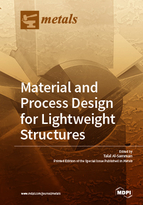Material and Process Design for Lightweight Structures
A special issue of Metals (ISSN 2075-4701). This special issue belongs to the section "Biobased and Biodegradable Metals".
Deadline for manuscript submissions: closed (31 December 2018) | Viewed by 45345
Special Issue Editor
Interests: lightweight materials; magnesium alloys; plastic deformation; recrystallization and grain growth; texture and microstructure; mechanical properties
Special Issues, Collections and Topics in MDPI journals
Special Issue Information
Dear Colleagues,
The drive toward increased fuel efficiency and a reduction in the harmful emission of greenhouse gases associated with energy generation and transportation has led, in recent years, to a resurgence of interest in light alloys and new lightweight alloy design strategies. In automotive industry, the need to reduce vehicle weight has led to extensive research efforts to develop aluminum and magnesium alloys for structural car body parts. In aerospace, the move toward composite airframe structures demands an increased use of formable titanium alloys. In steel research, there are also major efforts to design novel damage-controlled forming processes for a new generation of efficient and reliable lightweight steel components. These materials constitute today’s research mission for lightweight design. They provide a fertile materials science research field aiming to achieve a better understanding of the interplay between industrial processing, developing microstructures, and the resulting material properties.
Given the extensive scientific and technological importance of this timely subject, it is expedient to collect concise reports—to be presented in this Special Issue—on the current status in the field in the areas of manufacturing and processing technologies of light metals, microstructure and texture manipulation, innovative alloy design concepts and advanced characterization methods and in-situ techniques. We will not be able to cover all the exciting work in this rapidly-growing field, but we certainly hope to provide the reader with a sense of where significant advances are being made, where critical issues remain unanswered, and, from the authors’ perspectives, where the field is heading in the near future.
Dr.-Ing. Talal Al-Samman
Guest Editor
Manuscript Submission Information
Manuscripts should be submitted online at www.mdpi.com by registering and logging in to this website. Once you are registered, click here to go to the submission form. Manuscripts can be submitted until the deadline. All submissions that pass pre-check are peer-reviewed. Accepted papers will be published continuously in the journal (as soon as accepted) and will be listed together on the special issue website. Research articles, review articles as well as short communications are invited. For planned papers, a title and short abstract (about 100 words) can be sent to the Editorial Office for announcement on this website.
Submitted manuscripts should not have been published previously, nor be under consideration for publication elsewhere (except conference proceedings papers). All manuscripts are thoroughly refereed through a single-blind peer-review process. A guide for authors and other relevant information for submission of manuscripts is available on the Instructions for Authors page. Metals is an international peer-reviewed open access monthly journal published by MDPI.
Please visit the Instructions for Authors page before submitting a manuscript. The Article Processing Charge (APC) for publication in this open access journal is 2600 CHF (Swiss Francs). Submitted papers should be well formatted and use good English. Authors may use MDPI's English editing service prior to publication or during author revisions.
Keywords
- light metals
- magnesium
- aluminum
- titanium
- alloy design
- microstructure
- damage
- processing
- mechanical properties
- advanced characterization






